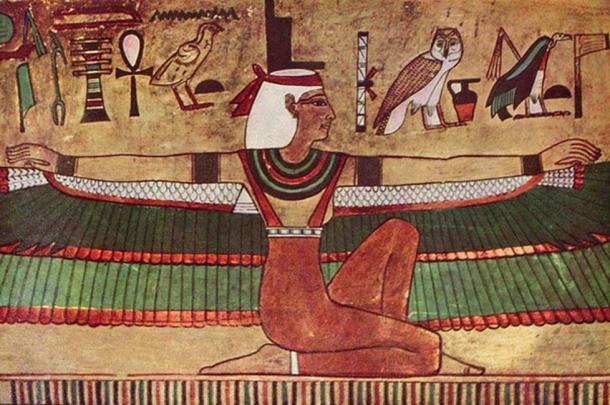
Changing Colors and Scampering Across the Night Sky: What Did the Ancients Say about Sirius?
In Egypt, Sirius was the Star of Isis, Isis being the companion and rescuer of the god Osiris. In a very deep way, Osiris was Egypt. His body was believed to be the body of Egypt, an actual overlay upon the land, and he (Egypt) returned to life each year with the flooding of the Nile. What was it that brought this renewal of life? The Star of Isis, the rescuer and life-giver, the soul of Egypt. Sirius’ annual appearance just before dawn at the summer solstice heralded the coming rise of the Nile, upon which Egyptian agriculture depended.
There are meanings under meanings in ancient Egyptian iconography, and we’re just beginning to understand their depth. Certainly Isis/Sirius was a companion and rescuer in the very practical context of the annual cycles, but we might also consider the larger cycle, and infer that as this “rescuer” star comes closer to Earth (as a binary companion would) the world will be “saved” from a dark age.

Mural depicting Isis in the tomb of Seti I in the Valley of the Kings (KV17). ( Public Domain)
Sirius: The Soul of Isis
The Isis connection with Sirius is found in many temple inscriptions, where the star is known as the Divine Sepat, identified as the soul of Isis. An inscription in the temple of Isis-Hathor at Dendera reads, “Her majesty Isis shines into the temple on New Year’s Day, and she mingles her light with that of her father on the horizon.” It is on this date that Sirius is near its zenith, bathing the open courtyards of the temple with its light.
- Did Ancient Aliens Impart Advanced Astronomical Knowledge to the Dogon Tribe?
- What is so Special About Sirius, the Dog Star?
- Dog Days of Summer: The Rising of the Dog Star, Sirius
One of the most interesting ancient facts about Sirius is the number of times the Sumerian and Egyptian texts describe it as red in color. All these references were made before 500 AD. After that date, historical references to Sirius describe it as blue. Today, anyone can look up into the night sky and see that Sirius is the bluest and brightest star in the sky. This observation of two different colors, dating from both sides of the low point of the Dark Ages, might lend support to Sirius as our companion star, as we will show in a moment.

The figures represented in the ancient Egyptian Dendera Zodiac. (CC BY 4.0)
Why the Color Change?
Now, any visible companion star should register a fair amount of proper motion (relative to other stars, not to Earth coordinates), because both the Sun and the companion star would be traveling around the same center of mass (common point of gravity between two binary stars), and this would produce several interesting phenomena. For half the cycle the two stars would be moving roughly toward one another (in an arc), and for the other half they would be moving away from one another. If they are moving at a fast-enough speed it is possible that we might see a red or blue shift in the star’s apparent color, depending on the direction of their course. This is the “Doppler effect,” which tells us whether a source of light or sound is moving closer to us or farther away. Astronomers use this technique in studying the motion of galaxies. It was the basis for the original formation of the theory of the expanding universe (because most galaxies are “red-shifted” they are deemed to be moving away, implying that the universe is spreading out). Could this explain why the Sumerians and Egyptians and others described Sirius as red? Was it moving away from us until apoapsis (its furthest point in 500 AD) and then its color “shifted” to blue as it began moving toward us at a rapid speed?
There is a Hopi story that lends further credence to the shift in color; it also ties it to a possible change in world ages: “When the blue star Kachina makes its appearance in the heavens, the Fifth World will emerge.” But the ancient Shinto of Japan were the clearest; they called Sirius our second sun and aligned their temples in its direction.

Ueno Tousyougu Japanese Shinto Temple. (Wei-Te Wong/CC BY SA 2.0)
While this is interesting supportive evidence for the Sirius binary scenario, some astronomers offer a different reason for the historical change in Sirius’ color, saying that Sirius B must have been a Red Giant that collapsed into a White Dwarf – and that’s why it changed color. While it is true that this is how White Dwarfs are supposed to form, no self-respecting astrophysicist would ever tell you it could be done in less than 10,000 years, and most would say the process should take millions of years. To happen in just a few hundred years is preposterous. The Red Giant collapse theory is just not a viable explanation for the recent rapid change in the color of Sirius.
There are also some historical legends about how Sirius has apparently moved over the years and “crossed over” the Milky Way. The following excerpt is from a paper written by astronomer J. Ellard Gore in Dublin, 1903:
“The Persian Astronomer, Abd-al-Rahman Al-Sufi, in his interesting ‘Description of the Fixed Stars’ written in the 10th century, says with reference to Sirius, “The Arabians call the brilliant and great star which is in the mouth, al-schira al-abur, Sirius which has passed across, also al-schira al-Jumaniji, Sirius of Yemen. It is called al-abur, because it has passed across the Milky Way into the Southern region. He then relates a mythological story of why Sirius “fled towards the south,” “and passed across the Milky Way towards Suhail (Canopus).” Now it seems to me a remarkable fact that the large proper motion of Sirius…would have carried it across the Milky Way in a period of about 60,000 years. Possibly the Arabian story might be based on a tradition of Sirius having been seen on the opposite, or eastern side of the Milky Way by the men of the Stone Age. However this may be, we know from the amount and direction of the proper motion of Sirius that it must have passed across the Milky Way within the periods above stated. The Arabic name al-abur is not therefore a fanciful name, but denotes an actual fact. The proper motion of Sirius could not possibly have been known to the ancients, as it has only been revealed by accurate modern measures.”

Artist's conception of the Milky Way. (Public Domain)
With reference to Procyon, Al-Sufi says that when Sirius “passed across the Milky Way, Procyon remained in the region to the North-east of the Milky Way.” This is also correct, for the proper motion of Procyon is very similar in direction and amount to that of Sirius, and 60,000 years ago it was in the constellation Cancer, not far from the star Cancri. 60,000 years hence, Procyon will be near the star Canis Majoris, and will then, in its turn, have passed across the Milky Way.

Procyon (top left), Betelgeuse (top right), and Sirius (bottom) form the Winter Triangle. Orion is to the right. (Public Domain)
These are intriguing comments from an early 20th century scientist interpreting remarks made by a 10th century astronomer, interpreting still older observations of this unusual star. But there is of course another way to decipher this information, and that is the binary interpretation.
- The Valley of the Kings and the Hopi: Constellations Send Ancient Messages
- The Secret of Gobekli Tepe: Cosmic Equinox and Sacred Marriage - Part 1
- Was Orion the Heavenly Overlord of Stonehenge?
Explaining the Movement of Sirius with the Binary Interpretation
If our scenario is correct, and Sirius is the dual, then it could have crossed the Milky Way in far less time than the 60,000 years postulated above. In fact, a star in a 24,000-year binary system could traverse a quarter of the sky in the time it takes to complete one quarter of its binary orbit, roughly 6,000 years. Obviously, this would mean that Sirius’ motion must at times be greater than current observations would indicate. However, and this is an important point, it would not be seen to have a ridiculous proper motion relative to Earth coordinates (right ascension and declination) because of the gravitational bond between the two stars. Binaries are always at opposite ends of the common center of mass. Like two points on opposite ends of a bicycle wheel they move a lot compared to outside objects but hardly at all relative to each other. Sirius’ proper motion would only be apparent relative to stars in its region of the sky, and even then it would be hard to notice unless you compared photographs taken from almost the exact same spot at the same time of year several hundred years apart. Still, it would scamper across the sky compared to other stars. Could Sirius be moving faster than expected? Several sources indicate that it might be. The best way to tell may be to compare its motion to the calendar.

Sirius, the brightest star in the night sky. (Mellostorm/CC BY SA 3.0)
According to researcher and historian Cyril Fagan, “For Egypt and Babylonia, the length of Sirius’ heliacal year is almost exactly the same as the Julian year (see J.K. Fotheringham’s The Calendar, British Nautical Almanac, 1935) with the result that Sirius rose heliacally on almost the same Julian date for 4000 years (see Zodiacs, Old and New, table X, p.78).” He then provides us with the dates of the heliacal rising in Egypt (in Heliopolis), based on the calendar established by Julius Caesar in 45 BC, which has 365.25 days in a year.
Top Image: The astronomical ceiling at the Pronaos, Detail of the first Band west from the center. From left to right: two wind creatures (the winged ram with four heads personifies the south wind), the snake- and frog-headed eight goddesses and gods of the Ogdoad who ruled the cosmos before the creation of the world and Osiris seated on a throne sails across the sky as personification of the full moon accompanied by the seated goddesses Nephtys (left) and Isis on the right (Maat stands near the bow of the ship). Sirius was the star of Isis. Source: kairoinfo4u/CC BY NC SA 2.0
















Comments
The references to “its furthest point in 500AD” and “a 24,000 year binary” are extraordinary in this context. According to the Indian Swami (holy man) Sri Yukteswar’s book “The Holy Science” there is a 24,000 year cycle of ascending and descending ages in human affairs, and a new cycle began when Earth reached the lowest point of the cycle (grimmest, most materialistic)in 500CE.
Wade Miller-Knight
You left out the most important part of the Hopi prophecy "when the Blue Star Kachina appears on earth our time is ended & the world as we know it will change". That fits in with the idea that the star is moving closer to the earth and will collide with us and knock the earth off it's axis again. What was once frozen will become warm and desert will support life.